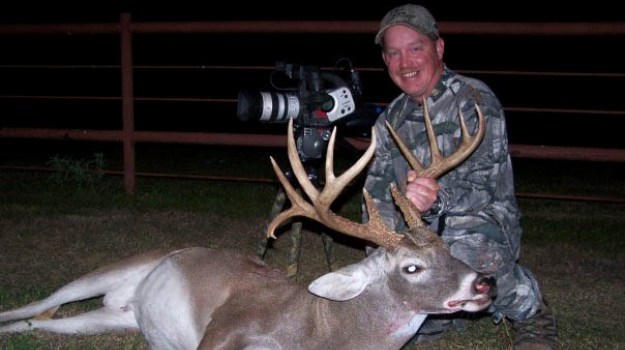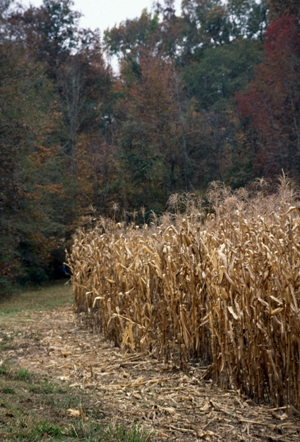
Four Tips for Early Bow Season with Mossy Oak’s Parrish Elliott
Editor’s Note: Parrish Elliott of Fairview, Tennessee, just outside of Nashville, has been a Mossy Oak Pro for 7 years, a deer hunter for 25 years and a bowhunter for 20 years and has taken more than 80 deer with his bow.
Hunt the edges of agricultural fields at the beginning of bow season, until the white oak acorns start to drop, or until there is no-more food left in the agricultural fields, since the deer feed there all summer long. As long as there is something green to eat or soybeans or corn in those fields, the deer usually will stay and use these fields as a primary food source. However, when the white oak acorns begin to drop, the sound of those acorns falling is like music coming from the popsicle or the ice cream truck. The deer just have to go to them.
There are two ways to know when the deer move from the crops to the white oaks. After the corn or soybeans are cut, you usually will see fewer deer in the crop fields. Cleaning up the spilt beans or corn won’t take long. Then they’ll move to the hardwoods. Another way you can tell when the deer are leaving the crops and moving to the hardwoods is to walk through the hardwoods, listen for the acorns to drop, and look for squirrels. Squirrels feed on acorns just like deer do. If squirrels are running through the oaks hunting acorns, they often bounce on the limbs and cause the ripe acorns to fall. When the deer make this transition from the crops to the acorns, this is when I start putting-out my Covert game cameras, because they take good quality pictures, and I don’t have to maintain them. They also have a fast shutter speed that produces a higher-resolution picture.
A few years ago, when Mossy Oak reintroduced Bottomland camo, I found some deer feeding on white oaks. I set-up a ladder stand that was12-foot off the ground, near a cluster of white oak trees that was dropping acorns and where several trails came out of the bedding area and went to the trees dropping acorns. I had three, 4- to 6-point bucks under my tree stand that remained there for 15 minutes. Several times different bucks would look-up at me. Because I stayed motionless, and that Mossy Oak Bottomland camo looked just like the tree trunk my ladder was up against, the deer never saw me. I was invisible to them.
 All of a sudden, all three bucks’ heads came up, and they all looked up the hill. Moving very slowly, I turned my head to look in the direction the deer were watching. I spotted a fine 8-point buck walking down the hill. As soon as I saw him, I made the decision to take him. As the 8-point buck kept getting closer, I knew I couldn’t draw until all the bucks either had their heads down feeding or were all looking away from me. Don’t focus all your attention on the one buck you are trying to arrow and forget about the other deer that are around your stand. I often think this is the reason why some bowhunters don’t take the bucks they want to, because we have to remember that all the deer within sight of us have the potential to spook the buck we want to take. So, one of the most-critical elements of getting the shot off is to make sure that all the deer, all the way around your tree stand, can’t spot you when you draw.
All of a sudden, all three bucks’ heads came up, and they all looked up the hill. Moving very slowly, I turned my head to look in the direction the deer were watching. I spotted a fine 8-point buck walking down the hill. As soon as I saw him, I made the decision to take him. As the 8-point buck kept getting closer, I knew I couldn’t draw until all the bucks either had their heads down feeding or were all looking away from me. Don’t focus all your attention on the one buck you are trying to arrow and forget about the other deer that are around your stand. I often think this is the reason why some bowhunters don’t take the bucks they want to, because we have to remember that all the deer within sight of us have the potential to spook the buck we want to take. So, one of the most-critical elements of getting the shot off is to make sure that all the deer, all the way around your tree stand, can’t spot you when you draw.
Finally, the buck was within 11 yards of my tree stand, and I took the shot. But when the buck wheeled and started running back up the hill, I thought I had missed him. Then he stopped and started stomping his feet, tipped over and began rolling down the hill. When he stopped rolling, he was only about 20-yards from me.
My PSE Omen Pro had done the job. I like this bow, because of the speed it can produce without having to pull a heavy draw weight. I have a short draw length – 27 inches, and I pull 66 pounds. The arrow flies like a streak of lightning, when I release the string. This is the reason I thought I might have missed the deer. At 11 yards, I couldn’t see the flight of the arrow, since it was traveling so fast at that close range.
Here are four tips for early bow season:
- Hunt the edges of agricultural fields until the acorns start falling.
- Look for trails, deer droppings and little funnels through the leaves where the deer have been using their noses to try and find acorns, once they start falling.
- Set-up trail cameras to be able to see the bucks and the does coming in to that tree to feed. You also can learn the directions that the deer use to come and go away from their feeding areas.
- Pick a stand site on the trail between the deer’s bedding and feeding areas to hunt with your bow.
Tomorrow: Mossy Oak’s Parrish Elliott Says to Stay Away from the Deer






























